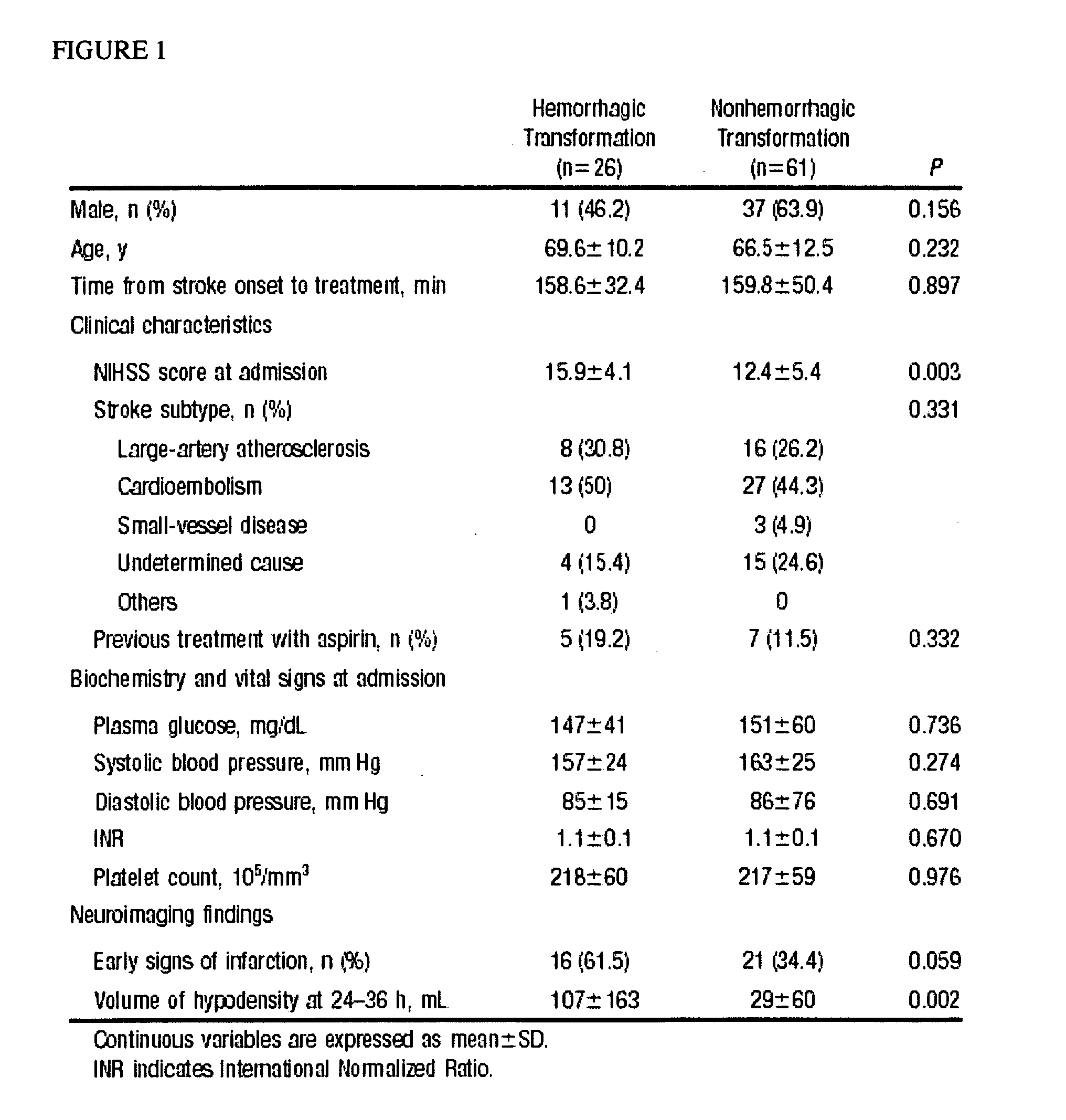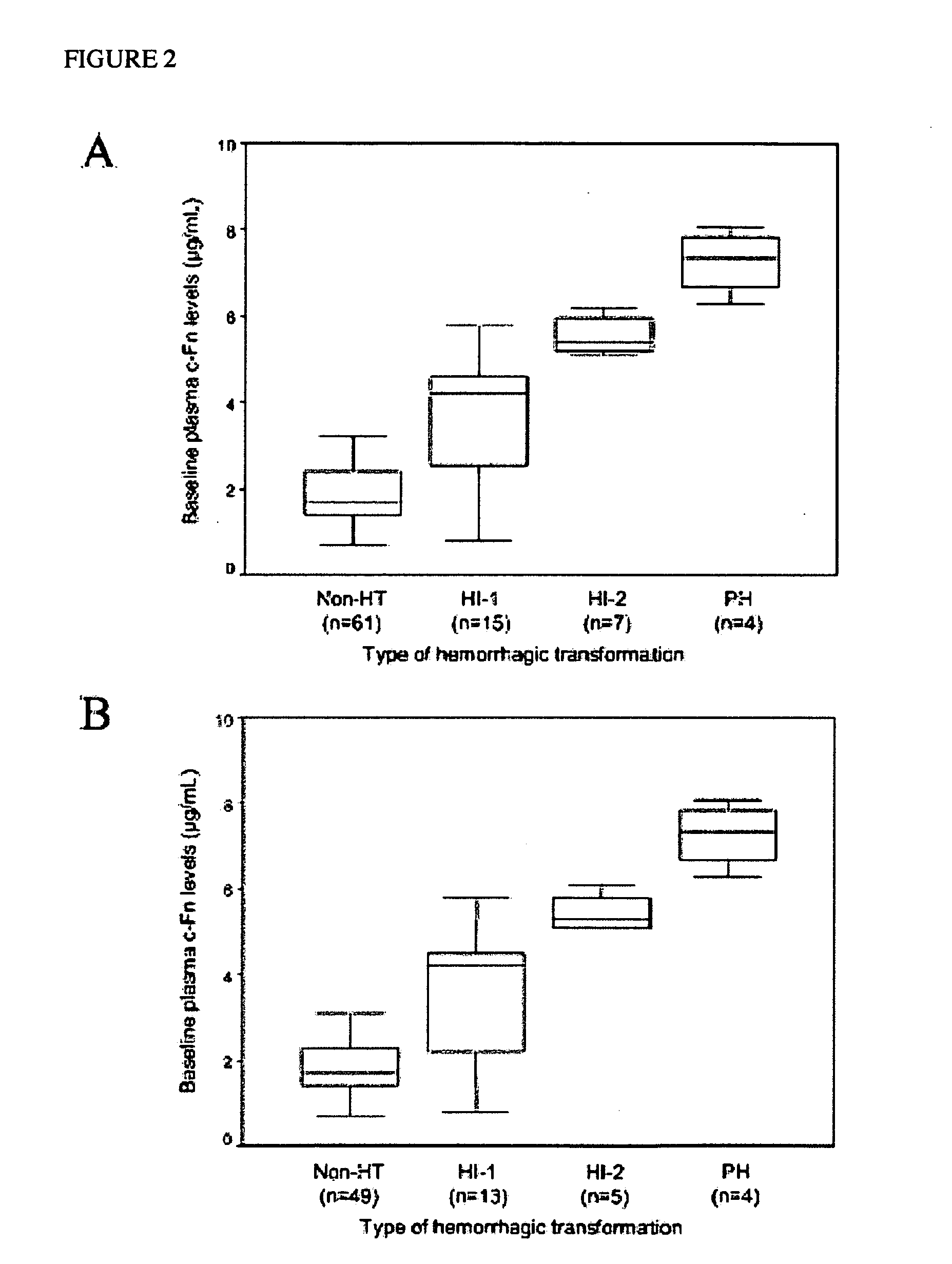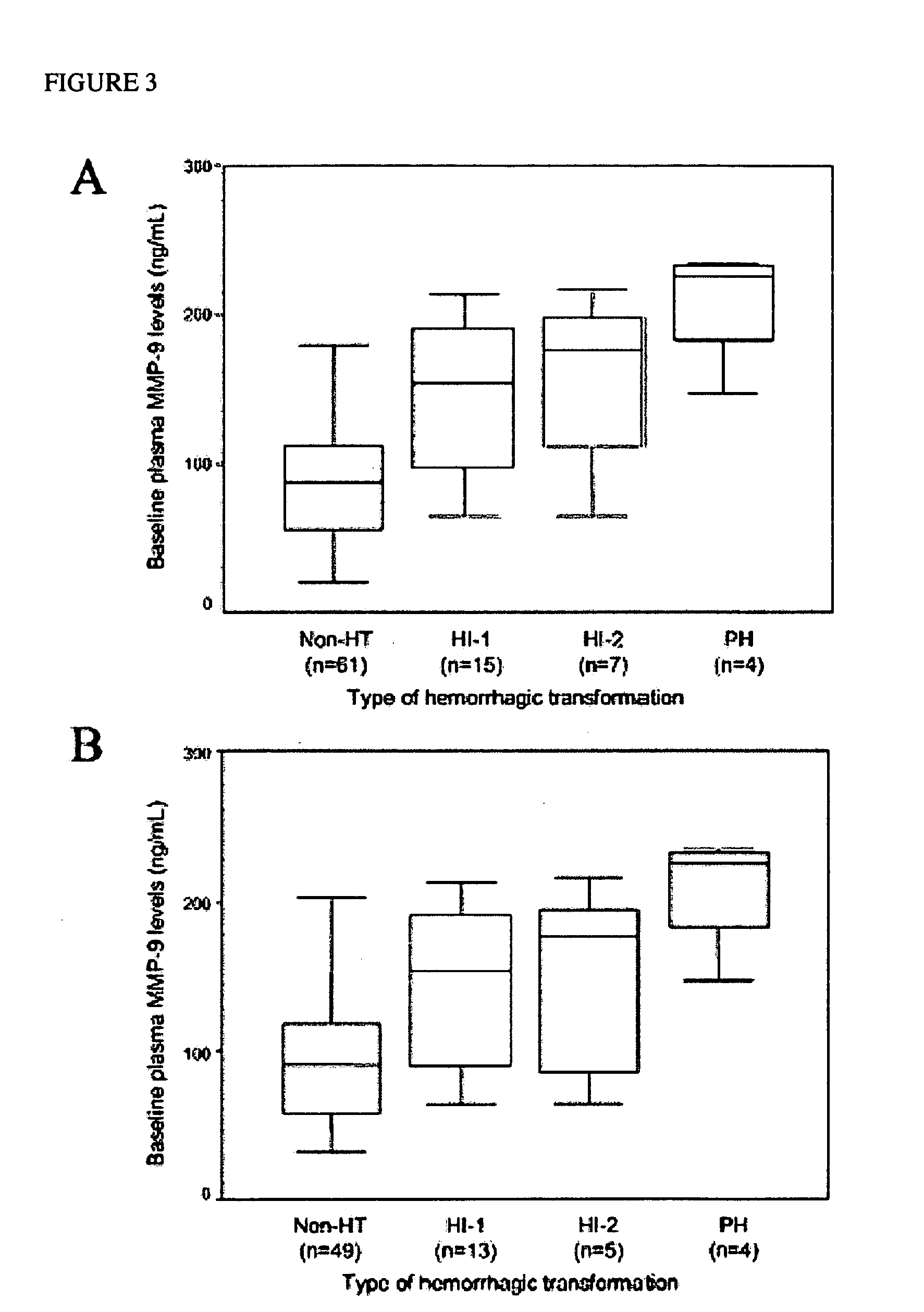[0026] In one of its aspects, the invention discloses methods for determining a diagnosis or prognosis related to a cardiac event such as stroke, or for differentiating between stroke sub-type and / or determination of HT. The preferred method includes analyzing a fluid sample obtained from a person who has an unknown diagnosis for the levels of one or more markers specific to the damage caused by said cardiac event. In the case of stroke, these markers would be drawn from the group consisting of markers relating to vascular damage, glial activation, inflammatory mediation,
thrombosis, cellular injury,
apoptosis,
myelin breakdown, and specific and non-specific markers of
cerebral injury. The analysis of the preferred method thus more precisely includes identifying one or more markers the presence or amount of which is associated with the diagnosis, prognosis, or differentiation of stroke and / or determination of HT. Once such marker(s) are identified, the next in the method the level of such marker(s) in a sample obtained from a subject of interest can be measured. In certain embodiments of the preferred method, these markers can be compared to a level that is associated with the diagnosis, prognosis, or differentiation of stroke and / or determination of HT. By correlating the subject's marker level(s) to the
diagnostic marker level(s), the presence or absence of stroke, and also the probability of future
adverse outcomes, etc., in a patient may be rapidly and accurately determined.
[0027] In another of its aspects, the instant invention is embodied in methods for choosing one or more marker(s) for differentiation of stroke and / or determination of HT that together, and as a group, have maximal sensitivity, specificity, and
predictive power. Said maximal sensitivity, specificity, and
predictive power is in particular realized by choosing one or more markers as constitute a group by process of plotting
receiver operator characteristic (ROC) curves for (1) the sensitivity of a particular combination of markers versus (2) specificity for said combination at various cutoff threshold levels. In addition, the instant invention further discloses methods to interpolate the nonlinear correlative effects of one or more markers chosen by any methodology to such that the interaction between markers of said combination of one or more markers promotes maximal sensitivity, specificity, and predictive accuracy in the prediction of any of the occurrence of stroke, identification of stroke subtype, or likelihood of HT.
[0032] Thus, in certain embodiments of the methods of the present invention, a plurality of markers are combined using an
algorithm to increase the
predictive value of the analysis in comparison to that obtained from the markers taken individually or in smaller groups. Most preferably, one or more markers for vascular damage, glial activation, inflammatory mediation,
thrombosis, cellular injury,
apoptosis,
myelin breakdown, and specific and non-specific markers of
cerebral injury are combined in a single
assay to enhance the
predictive value of the described methods. This
assay is usefully predictive of multiple outcomes, for instance: determining whether or not a stroke occurred, then determining the sub-type of stroke, then further predicting stroke prognosis. Moreover, different marker combinations in the
assay may be used for different indications. Correspondingly, different algorithms interpret the marker levels as indicated on the same assay for different indications.
[0040] The term “markers of thrombosis” as used in this specification refers to markers that indicate an coagulation event in ischaemic stroke. The
blood clotting system is activated when blood vessels are damaged, exposing collagen, the major
protein that
connective tissue is made from. Platelets circulating in the blood adhere to exposed collagen on the
cell wall of the
blood vessel and secrete chemicals that start the clotting process as follows:
Platelet aggregators cause platelets to clump together (aggregate). They also cause the blood vessels to contract (vasoconstrict), which reduces
blood loss.
Platelet aggregators include
adenosine diphosphate (ADP),
thromboxane A2, and
serotonin (5-HT). Coagulants such as
fibrin then bind the platelets together to form a permanent plug (clot) that seals the leak.
[0048] Macrophages and T lymphocytes kill target cells by inducing
apoptosis, one of the potential mechanisms whereby the inflammatory cells invading the infarcted brain area participate in neuronal
cell death.
Stroke patients displayed an
intrathecal production of proinflammatory cytokines, such as
interleukin (IL)-1β, IL-6, IL-8, and
granulocyte-macrophage colony-stimulating factor (GM-CSF), and of the anti-inflammatory
cytokine IL-10 within the first 24 hours after the onset of symptoms, supporting the notion of localized immune response to the acute brain
lesion in humans. Some of these cytokines (eg, IL-1β and IL-8) stimulate influx of leukocytes to the infarcted brain, a prerequisite for Fas / APO-1- and bcl-2-mediated apoptosis. TNF-α, a powerful
cytokine inducing apoptosis in the extraneural compartment of the body, has been demonstrated to protect rat hippocampal, septal, and cortical cells against metabolic-excitotoxic insults and to facilitate regeneration of injured axons. More importantly, TNF-α and -β protect neurons against
amyloid β-
protein-triggered
toxicity.
[0055] In yet another of its aspects, the present invention is embodied in methods for determining a
treatment regimen for use in a patient diagnosed with stroke. The methods preferably comprise determining a level of one or more diagnostic or prognostic markers as described herein, and using the markers to determine a diagnosis for a patient. For example, a prognosis might include the development or predisposition to delayed neurologic deficits after stroke onset. One or more treatment regimens that improve the patient's prognosis by reducing the increased disposition for an adverse outcome associated with the diagnosis can then be used to treat the patient. Such methods may also be used to screen pharmacological compounds for agents capable of improving the patient's prognosis as above.
 Login to View More
Login to View More 


